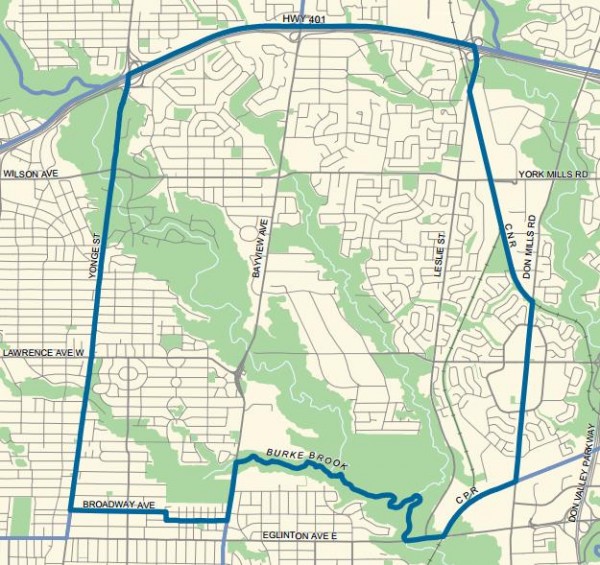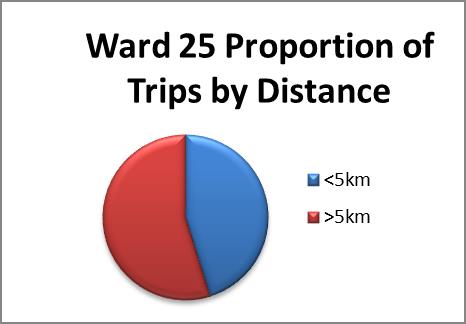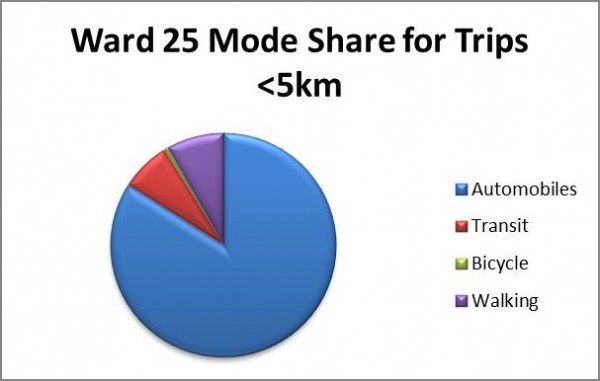This post, using Toronto’s Ward 25 as a case study, by researcher Trudy Ledsham is part of Spacing‘s partnership with the Toronto Cycling Think and Do Tank at the University of Toronto. Find out more about the think tank, and the series, here.
As the transit funding discussions in Toronto grow increasingly heated should we be thinking a little more about the humble bicycle, as well as high stakes subways and LRT? Transit investment is necessary. In fact, it is critical that Toronto start to build more effective methods of moving people. Traffic congestion is strangling the region, an experience all too common in urban areas across Canada.
But will transit solve all of Toronto’s traffic woes? 45% of all trips in Toronto were less than 5km long and 65% of these short trips were made by automobiles. Three of Toronto’s most congested intersections are along the Sheppard Subway line. These are not the trips pictured in lines snaking along expressways, for which there are few good alternatives. These are trips, within neighbourhoods, that create enormous street congestion for which, with some relatively minor infrastructure changes (in comparison to subways and LRT) there are excellent alternative choices. Studies show bicycles are often faster for trips under 5km and have added health and financial benefits.
In some neighborhoods, such as Ward 25 Don Valley West, which abuts the Yonge Street subway line on its western edge, and lies 2km south of the Sheppard subway line on its northern edge, 80% of all trips originating in the ward are taken by automobiles. Like the rest of the city, 45% of all trips originating in the ward are less than 5km. Automobile trips less than 5km long account for almost half (47%) of all automobile trips in the ward. Remarkably, 84% of trips less than 5km long are taken by automobile.
This is a ward with subway access along its entire western boundary. The Eglinton LRT will increase transit access along its southern boundary-but more transit will not likely solve this neighborhood’s congestion problem. It will reduce some of the arterial traffic along the Bayview, Leslie and Eglinton but it will not likely address those automobile trips which are less than 5km.
For the city as a whole, transit use declines from 23% to 17% for trips less than 5km. This makes sense; more people will walk and bike for shorter trips. But in Ward 25, transit use dropped by two thirds for trips less than 5km: 22% of trips > than 5km long were by transit while only 7% of trips <km long were by transit. And, while walking and cycling increased for trips less than 5km, residents were even more likely to use cars than for longer trips.
That may be because these shorter trips are within residential neighborhoods where transit does not exist and is unlikely ever to exist. 68% of trips in Ward 25 were not work related. The area lacks any cohesive cycling facilities and most of it is rated fairly poorly for walking by Walkability. Walkability will not likely be improved in the short term in this ward, for while its boundary aligns the subway system it is a fairly large, low-density wealthy, older, suburban residential area.
But, could the bicycle have a role to play here? At present there are essentially no bike lanes. Yet, the area has a number of important destinations including Sunnybrook and Bloorview Hospitals, York University’s Glendon Campus and the Yonge Eglinton employment hub. Three major shopping destinations (Shops at Don Mills, Fairview Mall and Bayview Village) are either in the ward or just over the edge of the ward. The traffic line-ups to drop children at the schools in the area are remarkable, if only for their length.
If even 10% of these short trips were taken by bicycle, congestion in the area would be dramatically improved. Many streets would be suitable for cycling infrastructure. Combined with behaviour change support, a shift in mode for short trips in the area could have a real impact on congestion. A behaviour change campaign in Bellingham, Washington, directed at these short trips, produced a 22% increase in walking trips; a 35% increase in bicycling trips; a 10% increase in bus trips; and a 13% decrease in vehicle trips. These are stunning numbers for a behaviour known to be difficult to impact.
The Big Move –which is Metrolinx’s plan to improve transportation in the Greater Toronto and Hamilton Area (GTHA) – includes money for cycling. It proposes $20 million per year, be invested, across the entire Greater Toronto and Hamilton Area (GTHA). At the same time, funding discussions for transit under The Big Move are in the neighborhood of $50 billion over 25 years. But, does this $50 billion fully address the 45% of automobile trips less than 5km long, where walking and especially cycling offer efficient and cost effective solutions? An investment in cycling infrastructure and behaviour change programming proportionate to its potential to reduce congestion is well worth considering.
The bicycle is an elegant, reasonably priced solution to short trip congestion.
Trudy Ledsham is the Project Coordinator at the Toronto Cycling Think & Do Tank.
For more information on the Toronto Cycling Think & Do Tank please visit their website www.torontocycling.org or email them at info@torontocycling.org




6 comments
Yes, very cheap improvements in bicycle infrastructure can yield a huge transportation benefit. The Netherlands has what is probably the best cycle infrastructure in the world, with 27% of all trips in the entire country by bike. This costs the Dutch a not-very-much 30 euros per person annually for all construction and maintenance costs. The health-care savings alone more than pay for this investment.
In addition to protected bike lanes, one key need in Ward 25 is to stop cut-through “rat-running” car traffic in residential neighbourhoods. This can best be done by neighbourhood connectors at key residential intersections that allow pedestrians and cyclists to go through but prevent cars.
The goal is to make walking, cycling and public transit the fastest, easiest and most convenient means of going from A to B for all these short trips. Ending cut-through car traffic is an important way to achieve this goal.
Good points, but I am not optimistic about how much taking up there will be for this idea. The simple fact is that for most people, driving for such a short distance is not a problem, and switching to bicycle will not offer much benefits for themselves (health benefits for sure, but it is less tangible for many). Say, if there is no congestion, the 5k trip would take 10 minutes by car; in congestion, it would take 15 or 20 (if the congestion is really bad) minutes, which is still totally tolerable for most people. Now by switching to cycling, it will take 20 minutes as well. This person will keep the car and insurance anyway, parking is cheap or free. Oh, there is also picking up the kids. It certainly helps to skip the line of parked cars, but how many new cyclists would be comfortable enough to take a kid on the bike? So all in all, I just don’t see a big incentive for the behaviour change? If many switches, there certainly would be significant benefit to OTHER drivers by cutting down the congestion, but not much benefits to the one who actually switch. Plus improved congestion will lure some of the swinging ones back into driving.
Improving cycling infrastructure is always gonna be a good thing for the city. But don’t expect it to be the magic bullet that can make behaviout change happen automatically. There is a small group who are already thinking of going cycling, only held back by the lack of infrastructure. But for most short-distance drivers, they will need another substantial benefits to pick cycling over driving, because, to put it simply, driving just isn’t bad enough for them. The only thing I can see that will trigger sizable behaviour change would be either huge increase to the cost of driving (big parking levy or big gas tax increase), or terrible and permanent congestion (which makes the 5k trip 25 minutes+, and won’t improve significantly even in case of a massive switching to cycling). Both are rather unlikely ATM.
As someone who has lived in Ward 25 for more than 20 years, I can offer the following perspectives of an ‘insider’. First, the original Don Mills development was designed for walkability. There are many connector shortcuts for pedestrians, which the locals would know. I can walk out to Leslie Street faster than my neighbours can drive out to it. Second, this is a relatively middle class, well educated, progressive neighbourhood. Which means that a marketing campaign on the benefits of getting around by bicycle within ward would be well received by the residents. The difficulty starts when you hit an arterial road. Leslie, Don Mills, Lawrence and York Mills would all need to be retrofitted with separated bike lanes. And it would have to be separated lanes because the speed of traffic outside of rush hour is in the 70 – 90 kph range. Coupled with offering all students, at say a grade 4 or 5 level, with a Can-Bike course as part of their curriculum, I think the results would be huge. Third, I’d just like to point out that Metrolinx’s committement to cycling is only lipservice. Having attending several meetings where the on-again, off-again Leslie/Eglinton station was being discussed, they refused to consider the possibility of a multi-modal hub, despite the fact that there is so much existing cycling infrastructure that could feed into a Leslie station. Metrolinx was repeatedly asked to take those numbers into consideration and they repeatedly refused to acknowledge that the possiblity even existed. Ward 25 is an ideal ward to use as a test case for increasing the share of trips by bicycle. I hope that the Think Tank pursues this, rather than just talks about it.
I used to think that driving and parking were ‘free’ … I knew that I paid for them indirectly but not directly and that was good enough. I tried to ‘save gas’ which was really the only way I could control my transport costs … but there was no way to see, minute by minute, how much gas I was actually using, and therefore, no real way to understand how much I was spending.
Then I participated in the Shuttle Challenge … and I highly recommend it to my friends and family. I attached a device to the OBDII port on my car dashboard and quickly learned how much those little short trips were costing me.
I always knew that a cold engine used more energy than a warm engine. I didn’t realize that a 5km trip on a cold engine could cost 25c more than with a warm engine. Similarly, I knew that idling wastes fuel … but the device showed me that 1 second of idling cost me 1c … so now I turn my car off at traffic lights and save between $0.40-$1.20 at each light. I used to drive around alone in car at any time of day but now try to avoid busy times and driving alone.
The point is that the 5km trip seems quick, easy and cheap in a car (especially if you completely ignore the $9000 average annual cost of car ownership, operations and maintenance in the GTA) but it costs you more than you think.
I hope that the think tank will consider engaging with the people at Shuttle and getting data about the real costs and benefits of car travel in Ward 25 … to compare against the cost and benefits of driving.
Cheers, Moaz
Moaz,
you are right. Driving is often consider “cheap” or “almost free” because most of its cost are hidden (road), subsidized (parking), fixed (insurance/deprecation) or hard to gauge on per trip basis. People will ignore hidden and fixed cost, parking is often very cheap or free outside of downtown core (and fixed on per-month basis in many workplace scenario), the only thing people count is gas. But in most case the short distance commuter will use the car for longer trips over the weekend, so it is very hard to know how much it really cost to drive to and from work, and people usually underestimate the cost of short trip and over-estimate the cost of long distance highway driving. If people have better idea how much gas it actually cost for those short trip, it will help them make a more informed decision on the relative benefit of cycling.
That said, even if they do know the cost, and even with huge cycling infrastructure improvement, I don’t really see existing car owners outside downtown core doing the switch en-mass. My wife actually has a short commute (4km+) in which 3 modes are possible, by car (10-15 minutes), by subway (15-20 minutes, both our house and her office are steps from subway), or by bicycle (20-25 minutes, she takes side streets to avoid riding on Bloor). Her case is really a prime example where alternatives to driving are completely viable, yet she still drives 90% of the times. Driving is just faster, easier and more flexible than TTC (I’d estimate around $1.50-2.00 per trip, including parking, excluding the hidden or fixed cost). She does cycle sometime in the summer and fall, mostly for the health benefit, but she won’t ride when it rains, or when she need to go to some other sites, or do grocery, or pick up kids, and so on, so in the end, she rides at most twice a week, often less. I know we will probably will save some money if we get rid of the car, but I won’t do it, because of the convenience (and assurance) it provides to have the car right in front of your door all the time. When you have kids, it is really difficult to make the jump (my wife actually suggested it when we moved downtown, but I rejected, and she has come to appreciate my decision). I think by the time the kids are older and the van is too old, I will try not to replace it and see how that arrangement works, but I would say that is maybe 10 years out.
That said, I do think many in the next generation, who do not own a car to begin with and are already comfortable with car-sharing and car-rental arrangement, will be much more likely to continue that arrangement when they start family (if they decide to and can afford to stay in town). For them, it is much easier to see the true cost of each car trip, which makes alternatives much more attractive.
I’d consider myself the most avid cyclist of ward 25 and all the points made in the article are correct. Now the issue is lack of connectivity due to 401 and of course aggressive driving in area especially along Bayview, Shepard and Leslie. Moreover, many of the paths that could be used within park such as Windfield’s Park are not road or hybrid bike friendly. Also as mentioned there are no signage to indicate routes in the area, as there are non really. I would think bike lanes plus signs could surely ensure riders and encourage the rest that alternatives exist.